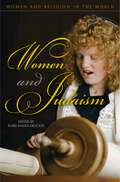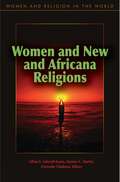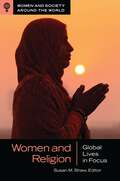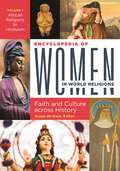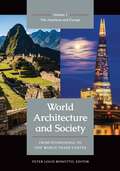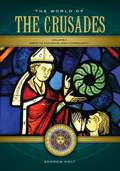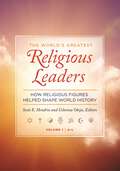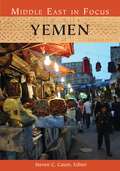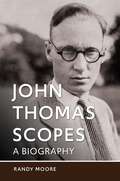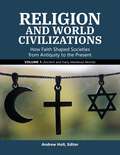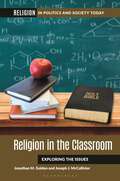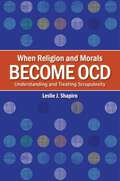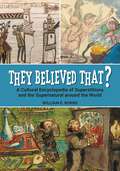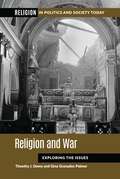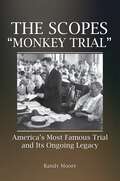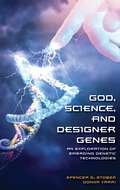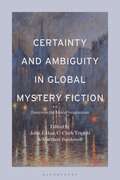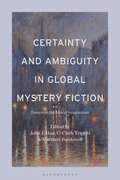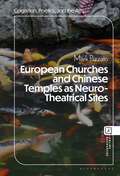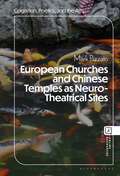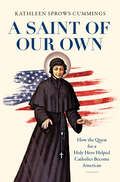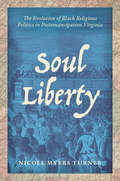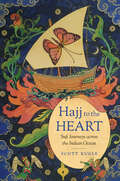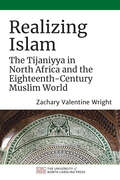- Table View
- List View
Women and Judaism (Women and Religion in the World)
by Malka DruckerContributors to Women and Judaism describe the many ways in which women are claiming a place in and changing the face of this ancient religion."Women and Judaism," the editor writes, "carries an intention to do more than bring the reader new ideas to ponder. For Jewish women, it's a charge to claim and re-claim their rightful place in their tradition … For non-Jewish sisters, we hope that it encourages you to bring change in your traditions as you learn of our effort to be counted as full members of an ancient spiritual community."In this all-encompassing exploration of Judaism for the modern woman, readers attend the first the Bat Mitzvah 70 years ago, hear an imagined response of biblical mothers asked to give up their children, and learn how each holiday contains an ecological message. Readers explore the power of women within a patriarchal tradition, including the story of the first woman rabbi. Readers see demonstrations of how women keep body, mind, and spirit alive, read a new view of biblical women as heroic role models, and enter the memory of women Holocaust survivors. Some contributors write about sexuality, power, and vulnerability, while others present the newest women's rituals, including Rosh Hodesh and mikveh.
Women and New and Africana Religions (Women and Religion in the World)
by Lillian Ashcraft-Eason Darnise Martin Oyeronke OlademoThis volume explores the lives of women around the world from the perspective of the New and Africana faiths they practice.This probing and thought-provoking series of essays brings together in one volume the multifaceted experiences of women in the New and Africana religions as practiced today. With this work, religion becomes a lens for examining the lives of women of diverse ethnicities and nationalities across the social spectrum.In Women and New and Africana Religions, readers hear from women from a number of religious/spiritual persuasions around the world, including Africa, Asia, the Caribbean, South America, and North America. These voices form the core of remarkable explorations of family and environment, social and spiritual empowerment, sexuality and power, and ways in which worldview informs roles in religion and society. Each essay includes scene-setting historical and social background information and fascinating insights from renowned scholars sharing their own research and firsthand experiences with their subjects.
Women and Religion: Global Lives in Focus (Women and Society around the World)
by Susan M. ShawThis volume offers students a broad examination of the impact of religion on the lives of women around the world, focusing on differences among women, indigenous religions, the impact of religion in colonization, and resistance to religious oppression.Sexism, pervasive in religion, limits access to high leadership positions; dictates gender-related religious practices and roles; portrays women in limited ways in sacred texts; excludes or condemns them if they are lesbian, bisexual, or transgender; and makes them subject to violence by people of other faiths as well as their own.This volume is organized into eight chapters, each focusing on a different region of the world—North America, Latin America and the Caribbean, Europe, North Africa and the Middle East, Sub-Saharan Africa, Central and East Asia, South and Southeast Asia, and Oceania. Chapters cover women's status and experiences in the religions of each region, including indigenous religions and such major world religions as Christianity, Judaism, Islam, Buddhism, and Hinduism. Additionally, they cover issues of religion for women, such as women in religious leadership, women in sacred texts, LGBTQ issues in religion, the intersections of religion and politics for women, the legacy of Christian missionaries on the colonial project, religious violence against women, and women's resistance to religious oppression.
Encyclopedia of Women in World Religions [2 volumes]: Faith and Culture across History [2 volumes]
by Susan De-GaiaThis reference offers reliable knowledge about women's diverse faith practices throughout history and prehistory, and across cultures.Across the span of human history, women have participated in world-building and life-sustaining cultural creativity, making enormous contributions to religion and spirituality. In the contemporary period, women have achieved greater equality, with more educational opportunities, female role models in public life, and opportunities for religious expression than ever before. Contemporaneously with this increased visibility, women are actively and energetically engaging with religion for themselves and for their communities. Drawing on the expertise of a range of scholars, this reference chronicles the religious experiences of women across time and cultures. The book includes sections on major religions as well as on spirituality, African religions, prehistoric religions, and other broad topics. Each section begins with an introduction, followed by reference entries on specialized subjects along with excerpts from primary source documents. The entries provide numerous suggestions for further reading, and the book closes with a detailed bibliography.
World Architecture and Society [2 volumes]: From Stonehenge to One World Trade Center [2 volumes]
by Peter Louis BonfittoThis two-volume encyclopedia covers buildings and sites of global significance from prehistoric times to the present day, providing students with an essential understanding of architectural development and its impact on human societies.This two-volume encyclopedia provides an in-depth look at buildings and sites of global significance throughout history. The volumes are separated into four regional sections: 1) the Americas, 2) Europe, 3) Africa and the Middle East, and 4) Asia and the Pacific. Four regional essays investigate the broader stylistic and historical contexts that describe the development of architecture through time and across the globe. Entries explore the unique importance of buildings and sites, including the megalithic wonder of Stonehenge and the imposing complex of Angkor Wat.Entries on Spanish colonial missions in the Americas and the medieval Islamic universities of the Sahara connect to broader building traditions. Other entries highlight remarkable stories of architectural achievement and memory, like those of Tuskegee University, a site hand-built by former slaves, or the Hiroshima Peace Memorial Park, which was built at the site of the atomic detonation. Each entry focuses on the architectural but includes strong consideration of the social impact, importance, and significance each structure has had in the past and in the present.
The World of the Crusades [2 volumes]: A Daily Life Encyclopedia [2 volumes] (Daily Life Encyclopedias)
by Andrew HoltUnlike traditional references that recount political and military history, this encyclopedia includes entries on a wide range of aspects related to daily life during the medieval crusades.The medieval crusades were fundamental in shaping world history and provide background for the conflict that exists between the West and the Muslim world today. This two-volume set presents fundamental information about the medieval crusades as a movement and its ideological impact on both the crusaders and the peoples of the East. It takes a broad look at numerous topics related to crusading, with the goal of helping readers to better understand what inspired the crusaders, the hardships associated with crusading, and how crusading has influenced the development of cultures both in the East and the West.The first of the two thematically arranged volumes considers topics such as the arts, economics and work, food and drink, family and gender, and fashion and appearance. The second volume considers topics such as housing and community, politics and warfare, recreation and social customs, religion and beliefs, and science and technology. Within each topical section are alphabetically arranged reference entries, complete with cross-references and suggestions for further reading. Selections from primary source documents, each accompanied by an introductory headnote, give readers first-hand accounts of the crusades.
The World's Greatest Religious Leaders [2 volumes]: How Religious Figures Helped Shape World History [2 volumes]
by Scott E. Hendrix Uchenna OkejaThis book provides reliable information about important world religious leaders, correcting the misinformation that can be on the internet.Religious leaders have shaped the course of history and deeply affected the lives of many individuals. This book offers alphabetically arranged profiles of roughly 160 religious leaders from around the world and across time, carefully chosen for their impact and importance and to maximize inclusiveness of faiths from around the world. Scholars from around the world, each one an expert in his or her field and all holding advanced degrees, came together to create an essential resource for students and for those with an interest in religion and its history. Every entry has been carefully edited in a two-stage review process, guaranteeing accuracy and readability throughout the work. Not strictly a biographical reference that recounts the facts of religious figures' lives, the book helps users understand how the selected figures changed history. The entries are accompanied by excerpts of primary source documents and suggestions for further reading, while the book closes with a bibliography of essential print and electronic resources for further research.
Yemen (Middle East in Focus)
by Steven C. CatonYemen is a country that is critical to U.S. security and our political interests, yet most Americans know virtually nothing about it. This book unlocks its secrets and explains its complexities in simple yet compelling language.A nation with a rich civilization that has spanned 3,000 years, Yemen is the only democratic republic in the Arabian Peninsula. While events in modern-day Yemen are often in international news, most Americans know nothing about this country—nor are there easy-to-read, up-to-date resources for lay audiences. This book fills the gap in the literature. It describes Yemen's geography, economy, politics and government, history, culture, society and contemporary events, presenting a comprehensive but accessible overview of the country from many different angles—coverage that is long overdue.Editor Steven C. Caton has taken care to create a resource that is readily comprehensible to non-specialists such as high school and college students and general readers as well as highly informative for those with previous knowledge about Yemen. His thorough treatment provides synthetic overviews of key topics, discusses and dismisses certain misconceptions about Yemen, offers surprising perspectives on the relatively unknown country, and underscores Yemen's importance to the region and the wider world—both in ancient times and today.
John Thomas Scopes: A Biography
by Randy MooreThis is the first comprehensive, annotated biography of John Scopes, the famed defendant in the Scopes Monkey Trial. This biography uses new, never-before-published sources, photographs, and stories from untapped sources-John Scopes's family and friends.In 1967, John Scopes published his memoirs, which focused overwhelmingly on his eight-day trial and not on the rest of his life, ignoring several important events, such as his divorce and remarriage, his run for the U.S. Congress, and his challenges with his family. This volume is the first complete, annotated biography of John Scopes. It details his entire life and, where appropriate, those of his parents, siblings, wife, and children, all supported by hundreds of cited sources, quotations, and family stories.Ideal for readers with an interest in academic freedom, free speech, or the evolution-creationism controversy, this book uncovers the facts of Scopes's post-trial life, including the challenges that Scopes faced in his personal life, his conversion from a socialist to a political conservative, and his final years and death. Readers will be surprised to learn that John Scopes's life differed significantly from what has often been presented in the media.
Religion and World Civilizations [3 volumes]: How Faith Shaped Societies from Antiquity to the Present [3 volumes]
by Andrew HoltAn indispensable resource for readers investigating how religion has influenced societies and cultures, this three-volume encyclopedia assesses and synthesizes the many ways in which religious faith has shaped societies from the ancient world to today. Each volume of the set focuses on a different era of world history, ranging through the ancient, medieval, and modern worlds. Every volume is filled with essays that focus on religious themes from different geographical regions. For example, volume one includes essays considering religion in ancient Rome, while volume three features essays focused on religion in modern Africa. This accessible layout makes it easy for readers to learn more about the ways that religion and society have intersected over the centuries, as well as specific religious trends, events, and milestones in a particular era and place in world history.Taken as a a whole, this ambitious and wide-ranging work gathers more than 500 essays from more than 150 scholars who share their expertise and knowledge about religious faiths, tenets, people, places, and events that have influenced the development of civilization over the course of recorded human history.
Religion in the Classroom: Exploring the Issues (Religion in Politics and Society Today)
by Jonathan M. Golden Joseph J. McCallisterAn indispensable resource for understanding religion's place in American schools and in matters concerning the separation of church and state in the United States.The framers of the American Constitution, in drafting the so-called "Establishment Clause" of the First Amendment-Congress shall not establish nor prohibit the practice of religion-intentionally juxtaposed two seemingly contrasting articles, understanding that we would grapple with these questions anew each day. And, indeed, we have. This book treats the Constitution, and the First Amendment in particular, as a living document, one that requires interpretation and re-interpretation on a regular basis as our nation and its people evolve. The book begins with an overview essay discussing the background of the contemporary debate over religion in schools. A timeline then highlights key events related to religion and education. Approximately 50 alphabetically arranged reference entries follow. These focus on contemporary concerns and provide objective, fundamental information about events, legislation, people, and other topics. The entries provide cross-references and suggestions for further reading, and the volume closes with an annotated bibliography.
When Religion and Morals Become OCD: Understanding and Treating Scrupulosity
by Leslie J. ShapiroThis essential resource brings recognition to scrupulosity and moral perfectionism, an often overlooked and misunderstood subtype of Obsessive Compulsive Disorder (OCD).Two to three percent of the global population suffer from OCD. Of that number, approximately five percent of OCD sufferers report having religious or moral obsessions. Scrupulosity, an often under-recognized subtype of OCD, leads those affected to mistake clinical OCD symptoms for committing sins, offending God, or being morally corrupt. Many people with scrupulosity or moral perfectionism turn to clergy for help rather than a mental health professional.This book, authored by a therapist among the most experienced in the world in dealing with this disorder, covers the symptoms, diagnosis, history, development, causes, and treatment of scrupulosity. Intended for students, mental health professionals, and clergy, this essential resource includes the latest theory, research, treatments, and case studies necessary to recognize and destigmatize scrupulosity as well as encourage optimal treatment outcomes and relapse prevention.
They Believed That?: A Cultural Encyclopedia of Superstitions and the Supernatural around the World
by William E. BurnsThis encyclopedia is the perfect guide to the weird, magical, superstitious, and supernatural beliefs of people from all over the world.This book is devoted to those human beliefs that fall in the "gray zone" between science, religion, and everyday life-call them superstitious, supernatural, magical, or just wrong. In an often incomprehensible world where lightning or plague could end life quickly or drought could condemn a poor family to agonizing death, superstitious beliefs gave people a feeling of understanding or even control. They have continued to shape societies and cultures ever since.This book covers a range of superstitious, supernatural, and otherwise unusual beliefs from the ancient world to the early 19th century. More than 100 entries explain beliefs, discuss historical evidence, and explain how each belief differs across cultures. This book is a perfect gateway for anyone curious about superstitious and magical beliefs, with topics ranging from the everyday, such as dogs and iron, to legendary figures, such as Hermes Trismegistus and the Yellow Emperor.
Religion and War: Exploring the Issues (Religion in Politics and Society Today)
by Timothy J. Demy Gina Granados Ph.D.Looking at topics across the spectrum of America's wars, religious groups, personalities, and ideas, this volume shows that even in an increasingly secular society, religious roots and values run deep throughout American society and are elevated in times of war.There is a long and deep relationship between religion, politics, and war in U.S. history. While there is a constitutional and legal separation of religion and the state in American society, religion has been and remains a potent force in American culture and politics affecting many aspects of life, including perspectives on war and peace and the experience of war in U.S. history. From the American Revolution to the wars of the 21st century, religious values have informed and influenced American attitudes toward war and peace and have provided rationale for support and non-support of American participation in conflicts.An overview essay surveys the background and significance of religion in American culture and provides historical context for discussions of contemporary topics. A timeline highlights key events related to wars and conflicts. The volume then includes more than 50 topical essays that discuss specific wars as well as religious themes within culture and politics, ultimately providing a detailed overview of the intersection of religion, war, and politics in contemporary America.
The Scopes "Monkey Trial": America's Most Famous Trial and Its Ongoing Legacy (Images Of America Ser.)
by Randy MooreThis book introduces readers to the "Trial of the Century," revealing how the trial originated, what caused and happened during and after the trial, what happened to the trial's participants, and why the trial still matters nearly 100 years later.Ongoing controversies about school curricula, such as the teaching of Critical Race Theory and the role of parents in public education, can all be traced to the Scopes Trial. Today, the question remains: who controls the school curriculum? This was a foundational issue in the Scopes Trial, and we have been debating this question ever since. This book will help readers understand where these controversies originated and how courts, politicians, and the public handled these issues nearly a century ago.Featuring new information from previously untapped sources and providing an in-depth study of John Scopes himself, this book interrogates the facts, fictions, and legend of the Scopes Trial, which historians rank as one of the defining events of the 20th century. It is an ideal resource for anyone interested in the ongoing controversy about evolution, science, and religion in education and American life.
God, Science, and Designer Genes: An Exploration of Emerging Genetic Technologies (Non-ser.)
by Spencer S. Stober Donna YarriA biologist and a Christian theologian examine the scientific and philosophical implications and potential impacts of genetic technologies.God, Science, and Designer Genes: An Exploration of Emerging Technologies provides a unique approach to the central ethical dilemma in contemporary science, offering both an up-to-date account of the current state of genetic technologies and insightful discussions of the moral/theological questions these technologies raise.Coauthored by professors of biology and theology, God, Science, and Designer Genes examines a range of from-the-headlines issues, including the relationship between science and religion, "designing" our children, stem-cell research, cloning, genetics and behavior, genetics and privacy, and using genetic technologies for social justice. Who should benefit—personally and financially—from DNA technology? Who might be harmed? How do we protect individual rights and guard against discrimination? How will embryo modification affect the identity of those so modified? God, Science, and Designer Genes gives readers an eloquent, thoughtful, and objective foundation for considering these and other questions about the potential conflict between scientific achievement, personal faith, and social responsibility.
Certainty and Ambiguity in Global Mystery Fiction: Essays on the Moral Imagination
by John J. Han, C. Clark Triplett, and Matthew BardowellMystery fiction as a genre renders moral judgments not only about detectives and criminals but also concerning the cultural structures within which these mysteries unfold.In contrast to other volumes which examine morality in crime fiction through the lenses of personal guilt and personal justice, Certainty and Ambiguity in Global Mystery Fiction analyzes the effect of moral imagination on the moral structures implicit in the genre. In recent years, public awareness has attended to the relationship between social structures and justice, and this collection centers on how personal ethics and social ethics are bound together amidst the shifting moral landscapes of mystery fiction.Contributors discuss the interplay between personal guilt and social guilt – considering morality and justice on an individual level and at a societal level – using frameworks of certainty and ambiguity. They show how individual characters in works by Agatha Christie, Gabriel García Márquez, Natsuo Kirino, F.H. Batacan, and Stephen King, among others, may view their moral standing with certainty but clash with the established mores of their culture. Featuring essays on Japanese, Filipino, Indian, and Colombian mystery fiction, as well as American and British fiction, this volume analyzes social guilt and justice across cultures, showing how individuals grapple with the certainty, and, at times, the moral ambiguity, of their respective cultures.
Certainty and Ambiguity in Global Mystery Fiction: Essays on the Moral Imagination
Mystery fiction as a genre renders moral judgments not only about detectives and criminals but also concerning the cultural structures within which these mysteries unfold.In contrast to other volumes which examine morality in crime fiction through the lenses of personal guilt and personal justice, Certainty and Ambiguity in Global Mystery Fiction analyzes the effect of moral imagination on the moral structures implicit in the genre. In recent years, public awareness has attended to the relationship between social structures and justice, and this collection centers on how personal ethics and social ethics are bound together amidst the shifting moral landscapes of mystery fiction.Contributors discuss the interplay between personal guilt and social guilt – considering morality and justice on an individual level and at a societal level – using frameworks of certainty and ambiguity. They show how individual characters in works by Agatha Christie, Gabriel García Márquez, Natsuo Kirino, F.H. Batacan, and Stephen King, among others, may view their moral standing with certainty but clash with the established mores of their culture. Featuring essays on Japanese, Filipino, Indian, and Colombian mystery fiction, as well as American and British fiction, this volume analyzes social guilt and justice across cultures, showing how individuals grapple with the certainty, and, at times, the moral ambiguity, of their respective cultures.
European Churches and Chinese Temples as Neuro-Theatrical Sites (Cognition, Poetics, and the Arts)
by Prof. or Dr. Mark PizzatoCompares monumental designs and performance spaces of Christian, Buddhist, and related sanctuaries, exploring how brain networks, animal-human emotions, and cultural ideals are reflected historically and affected today as "inner theatre" elements. Integrating research across the humanities and sciences, this book explores how traditional designs of outer theatrical spaces left cultural imprints for the inner staging of Self and Other consciousness, which each of us performs daily based on how we think others view us. But believers also perform in a cosmic theatre. Ancestral spirits and gods (or God) watch and interact with them in awe-inspiring spaces, grooming affects toward in-group identification and sacrifice, or out-group rivalry and scapegoating. In a study of over 80 buildings – shown by 40 images in the book, plus thousands of photos and videos online – Pizzato demonstrates how they reflect meta-theatrical projections from prior generations. They also affect the embodied, embedded, enacted, and extended (4E) cognition of current visitors, who bring performance frameworks of belief, hope, and doubt to the sacred site. This involves neuro-social, inner/outer theatre networks with patriarchal, maternal, and trickster paradigms. European Churches and Chinese Temples as Neuro-Theatrical Sites investigates performative material cultures, creating dialogs between theatre, philosophy, history, and various (cognitive, affective, social, biological) sciences. It applies them to the architecture of religious buildings: from Catholic, Orthodox, and Protestant in Europe, plus key sites in Jerusalem and prior “pagan” temples, to Buddhist, Daoist, Confucian, and imperial in China. It thus reveals individualist/collectivist, focal/holistic, analytical/dialectical, and melodramatic/tragicomic trajectories, with cathartic poetics for the future.
European Churches and Chinese Temples as Neuro-Theatrical Sites (Cognition, Poetics, and the Arts)
by Prof. or Dr. Mark PizzatoCompares monumental designs and performance spaces of Christian, Buddhist, and related sanctuaries, exploring how brain networks, animal-human emotions, and cultural ideals are reflected historically and affected today as "inner theatre" elements. Integrating research across the humanities and sciences, this book explores how traditional designs of outer theatrical spaces left cultural imprints for the inner staging of Self and Other consciousness, which each of us performs daily based on how we think others view us. But believers also perform in a cosmic theatre. Ancestral spirits and gods (or God) watch and interact with them in awe-inspiring spaces, grooming affects toward in-group identification and sacrifice, or out-group rivalry and scapegoating. In a study of over 80 buildings – shown by 40 images in the book, plus thousands of photos and videos online – Pizzato demonstrates how they reflect meta-theatrical projections from prior generations. They also affect the embodied, embedded, enacted, and extended (4E) cognition of current visitors, who bring performance frameworks of belief, hope, and doubt to the sacred site. This involves neuro-social, inner/outer theatre networks with patriarchal, maternal, and trickster paradigms. European Churches and Chinese Temples as Neuro-Theatrical Sites investigates performative material cultures, creating dialogs between theatre, philosophy, history, and various (cognitive, affective, social, biological) sciences. It applies them to the architecture of religious buildings: from Catholic, Orthodox, and Protestant in Europe, plus key sites in Jerusalem and prior “pagan” temples, to Buddhist, Daoist, Confucian, and imperial in China. It thus reveals individualist/collectivist, focal/holistic, analytical/dialectical, and melodramatic/tragicomic trajectories, with cathartic poetics for the future.
A Saint of Our Own: How the Quest for a Holy Hero Helped Catholics Become American
by Kathleen Sprows CummingsWhat drove U.S. Catholics in their arduous quest, full of twists and turns over more than a century, to win an American saint? The absence of American names in the canon of the saints had left many of the faithful feeling spiritually unmoored. But while canonization may be fundamentally about holiness, it is never only about holiness, reveals Kathleen Sprows Cummings in this panoramic, passionate chronicle of American sanctity. Catholics had another reason for petitioning the Vatican to acknowledge an American holy hero. A home-grown saint would serve as a mediator between heaven and earth, yes, but also between Catholicism and American culture. Throughout much of U.S. history, the making of a saint was also about the ways in which the members of a minority religious group defined, defended, and celebrated their identities as Americans. Their fascinatingly diverse causes for canonization—from Kateri Tekakwitha and Elizabeth Ann Seton to many others that are failed, forgotten, or still under way—represented evolving national values as Catholics made themselves at home. Cummings's vision of American sanctity shows just how much Catholics had at stake in cultivating devotion to men and women perched at the nexus of holiness and American history—until they finally felt little need to prove that they belonged.
Soul Liberty: The Evolution of Black Religious Politics in Postemancipation Virginia
by Nicole Myers TurnerThat churches are one of the most important cornerstones of black political organization is a commonplace. In this history of African American Protestantism and American politics at the end of the Civil War, Nicole Myers Turner challenges the idea of black churches as having always been politically engaged. Using local archives, church and convention minutes, and innovative Geographic Information Systems (GIS) mapping, Turner reveals how freedpeople in Virginia adapted strategies for pursuing the freedom of their souls to worship as they saw fit—and to participate in society completely in the evolving landscape of emancipation. Freedpeople, for both evangelical and electoral reasons, were well aware of the significance of the physical territory they occupied, and they sought to organize the geographies that they could in favor of their religious and political agendas at the outset of Reconstruction. As emancipation included opportunities to purchase properties, establish black families, and reconfigure gender roles, the ministry became predominantly male, a development that affected not only discourses around family life but also the political project of crafting, defining, and teaching freedom. After freedmen obtained the right to vote, an array of black-controlled institutions increasingly became centers for political organizing on the basis of networks that mirrored those established earlier by church associations. We are proud to announce that this book will also be published as an enhanced open-access e-book on a companion website hosted by Fulcrum, an innovative publishing platform launched by Michigan Publishing at the University of Michigan Library. The Fulcrum version of the book can be located using this link: https://doi.org/10.5149/9781469655253_Turner.
Hajj to the Heart: Sufi Journeys across the Indian Ocean (Islamic Civilization and Muslim Networks)
by Scott KugleAgainst the sweeping backdrop of South Asian history, this is a story of journeys taken by sixteenth-century reformist Muslim scholars and Sufi mystics from India to Arabia. At the center is the influential Sufi scholar Shaykh Ali Muttaqi and his little-known network of disciples. Scott Kugle relates how Ali Muttaqi, an expert in Arabic, scriptural hermeneutics, and hadith, left his native South Asia and traversed treacherous seas to make the Hajj to Mecca. Settling in Mecca, he continued to influence his homeland from overseas. Kugle draws on his original translations of Arabic and Persian manuscripts, never before available in English, to trace Ali Muttaqi's devotional writings, revealing how the Hajj transformed his spiritual life and political loyalties. The story expands across three generations of peripatetic Sufi masters in the Mutaqqi lineage as they travel for purposes of pilgrimage, scholarship, and sometimes simply for survival along Indian Ocean maritime routes linking global Muslim communities. Exploring the political intrigue, scholarly debates, and diverse social milieus that shaped the colorful personalities of his Sufi subjects, Kugle argues for the importance of Indian Sufi thought in the study of hadith and of ethics in Islam. We are proud to announce that this book is freely available in an open-access enhanced edition thanks to TOME (Toward an Open Monograph Ecosystem)—a collaboration of the Association of American Universities, the Association of University Presses, and the Association of Research Libraries—and the generous support of Emory University and the Andrew W. Mellon Foundation. Learn more at the TOME website: openmonographs.org. The open-access enhanced edition of Hajj to the Heart can be found here: https://manifold.ecds.emory.edu/projects/hajj-to-the-heart
Realizing Islam: The Tijaniyya in North Africa and the Eighteenth-Century Muslim World (Islamic Civilization and Muslim Networks)
by Zachary Valentine WrightThe Tijaniyya is the largest Sufi order in West and North Africa. In this unprecedented analysis of the Tijaniyya's origins and development in the late eighteenth century, Zachary Valentine Wright situates the order within the broader intellectual history of Islam in the early modern period. Introducing the group's founder, Ahmad al-Tijani (1737–1815), Wright focuses on the wider network in which al-Tijani traveled, revealing it to be a veritable global Islamic revival whose scholars commanded large followings, shared key ideas, and produced literature read widely throughout the Muslim world. They were linked through chains of knowledge transmission from which emerged vibrant discourses of renewal in the face of perceived social and political corruption. Wright argues that this constellation of remarkable Muslim intellectuals, despite the uncertainly of the age, promoted personal verification in religious learning. With distinctive concern for the notions of human actualization and a universal human condition, the Tijaniyya emphasized the importance of the realization of Muslim identity. Since its beginnings in North Africa in the eighteenth century, the Tijaniyya has quietly expanded its influence beyond Africa, with significant populations in the Middle East, Southeast Asia, and North America. We are proud to offer this book in our usual print and ebook formats, plus as an open-access edition available through the Sustainable History Monograph Project.
